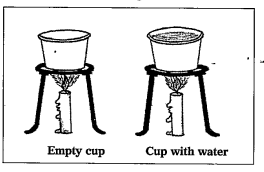Understanding ignition temperature.
Take two small paper cups. Pour cups.Pour water in one of the cups put the two cups on different tripod stands and heat both of them using a candle.
Which cup burn first?
 Solution in Telugu
Solution in Telugu
Step by step video & image solution for Understanding ignition temperature.Take two small paper cups. Pour cups.Pour water in one of the cups put the two cups on different tripod stands and heat both of them using a candle.Which cup burn first? by Chemistry experts to help you in doubts & scoring excellent marks in Class 7 exams.
Updated on:21/07/2023Topper's Solved these Questions
- COMBUSTION, FUELS AND FLAMEBOOK - NCERT TELUGUCHAPTER - COMBUSTION, FUELS AND FLAMEEXERCISE - EXERCISE
19 Videos
- COAL AND PETROLEUMBOOK - NCERT TELUGUCHAPTER - COAL AND PETROLEUMEXERCISE - EXERCISE
18 Videos
- HEAT - MEASUREMENTBOOK - NCERT TELUGUCHAPTER - HEAT - MEASUREMENTEXERCISE - Improve your learning
22 Videos
Similar Questions
Water is not used to control fires involving electrical equipment.Why?
View SolutionWhat is coal tar? How is it useful to us?
View SolutionThe normal temperature of human body is
View SolutionState two advantages of using disposable paper cups over disposable plastic cups.
View Solutionपानी को कागज के कप में गर्म किया जा सकता है क्योंकि-
View Solutionडिस्पोजेबल प्लास्टिक कप की अपेक्षा कागज के डिस्पोजेबल कप के इस्तेमाल के क्या लाभ है
View Solutionif A and B are two sets them
(A−B)∪(B−A)∪(A∩B)is equal to
View SolutionTake four peeled potato halves and scoop each one out to make potato cups. One of these potato cups should be made from a boiled potato. Put each potato cup in a trough containing water. Now,
(a) Keep cup A empty. (b) Put one teaspoon sugar in cup B. (c) Put one teaspoon salt in cup C.
(d) Put one teaspoon sugar in the boiled potato cup D.
Keep these for two hours. Then observe the four potato cups and answer the following:
Explain why water gathers in the hollowed portion of B and C.
View SolutionTake four peeled potato halves and scoop each one out to make potato cups. One of these potato cups should be made from a boiled potato. Put each potato cup in a trough containing water. Now,
(a) Keep cup A empty. (b) Put one teaspoon sugar in cup B. (c) Put one teaspoon salt in cup C.
(d) Put one teaspoon sugar in the boiled potato cup D.
Keep these for two hours. Then observe the four potato cups and answer the following:
Explain why water does not gather in the hollowed out portions of A and D.
View SolutionWater can be heated in a cup of paper because :
View SolutionCarry out the following osmosis experiment: Take four peeled potato halves and scoos each one out to make potato cups. One of these potato cups should be made from a boiled potato. Put each potato cup in a trough containing water.(a) Now, Keep cup A empty.(b)Put one teaspoon sugar in cup B.(c)Put one teaspoon salt in cup c.(d)put one teaspoon sugar in the boiled potato cup D.Keep these for two hours then observe the four potato cups and answer the following:Explain why water gathers in the hollowed portion of B and C.
View SolutionCarry out the following osmosis experiment: Take four peeled potato halves and scoos each one out to make potato cups. One of these potato cups should be made from a boiled potato. Put each potato cup in a trough containing water.(a) Now, Keep cup A empty.(b)Put one teaspoon sugar in cup B.(c)Put one teaspoon salt in cup c.(d)put one teaspoon sugar in the boiled potato cup D.Keep these for two hours then observe the four potato cups and answer the following: Explain why water does not gather in the hollowed out portion of A and D.
View SolutionThe symbol used for union of two sets is (a) ∩ (b) ∪ (c) both ∩and∪ (d) none of these
View SolutionUnderstanding ignition temperature. Take two small paper cups. Pour cups.Pour water in one of the cups put the two cups on different tripod stands and heat both of them using a candle. Which cup burn first?
View Solutioni) One cup can hold 13 litre of milk How much milk can we pour in two cups?. ii) In four cups?
View Solutionif A and B are two sets them
(A−B)∪(B−A)∪(A∩B)is equal to
View Solution
